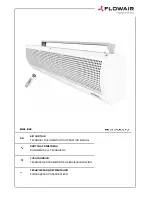
5.
Figure 8
Hanger
bracket
Canopy
Safety cable
Making the Electrical
Connections
If you feel you do not have enough electrical
wiring knowledge or experience, have your fan
installed by a licensed electrician.
This remote control unit is equipped with 16 code
combinations to prevent possible interference
from or to other remote units. The frequency
switches on your receiver and remote control have
been preset at the factory. Please recheck to make
sure the switches on the remote control and the
receiver are set to the same position. Any
combination of settings will operate the fan as long
as the switches in the remote control and receiver
are set to the same position. (Figure 9)
TO AVOID POSSIBLE ELECTRICAL SHOCK, BE
SURE ELECTRICITY IS TURNED OFF AT THE
MAIN FUSE BOX BEFORE WIRING.
NOTE
NOTE
FAN MUST BE INSTALLED AT A MAXIMUM
DISTANCE OF 20 FEET FROM THE
TRANSMITTING UNIT FOR PROPER
SIGNAL TRANSMISSION BETWEEN THE
TRANSMITTING UNIT AND THE FAN'S
RECEIVING UNIT.
1.
2.
3.
4.
(Figure 10) Insert the receiver into the
mounting bracket with the flat side of the
receiver facing the ceiling.
(Figure 11) Motor to receiver electrical
connections: Connect the black wire from the
fan to black wire marked "TO MOTOR L".
Connect the white wire from the fan to the
white wire marked "TO MOTOR N" from the
receiver. Connect the blue wire from the fan to
the blue wire marked "For Light" from the
receiver. Secure the wire connections with the
plastic wire connecting nuts provided.
(Figure 11) Receiver to house supply wires
electrical connections: Connect the black (hot)
wire from the ceiling to the black wire marked
"AC in L" from the receiver. Connect the white
(neutral) wire from the ceiling to the white wire
marked "AC in N" from the receiver. Secure
the wire connections with the plastic wire
connecting nuts provided.
(Figure 11) If your outlet box has a ground
wire (green or bare copper) connect it to the fan
ground wires; otherwise connect the hanging
bracket ground wire to the mounting bracket.
Secure the wire connection with a plastic nut
provided. After connecting the wires spread
them apart so that the green and white wires are
on one side of the outlet box and black and blue
wires are on the other side. Carefully tuck the
wire connections up into the outlet box.

































